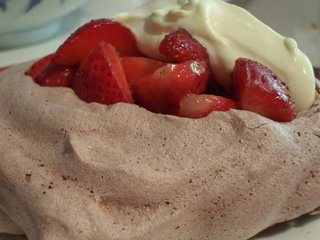Chocolate pavlovas
I’m not going to get into the debate regarding who invented the pavlova, supposedly named after Anna Pavlova because the meringue represented the fluffy white frou frou of her tutu. Whether it was Australia or New Zealand or Azerbijan, I’m just glad someone thought of it and Australia adopted it. And I’m glad someone thought of putting chocolate in it.

4 egg whites
¼ tsp cream of tartar
1 cup (220 g) caster sugar
2 tsp corn flour
2 tbsp cocoa powder (use Valrhona if you can)
1tsp white vinegar
Beat the egg whites with the cream of tartar until soft peaks form, then gradually add the sugar a little at a time until thoroughly beaten in and dissolved in the egg whites. Test a bit between the tip of your finger and thumb – you shouldn’t feel any grainy bits in the mixture. Sift the corn flour and the cocoa together and fold in gently to the egg whites. Fold in the vinegar.
Place 6 or 7 rounds of pavlova mixture onto a baking sheet lined with baking paper, making a small depression in the centre of each one with the back of a spoon. Bake at 120°C for 60 minutes (the recipe actually claims 45 minutes but they weren't cooked in this time in the fan forced oven I was using) or until they are dry and sound hollow when lightly tapped. Turn off the oven and leave the door ajar while they slowly cool for about an hour.
They're quite fragile, much moreso than a standard pav, so be careful when removing them to serve, use a pallette knife to lift them off the tray to a serving plate. Serve with berries and whipped cream in the centre of each little pav.
(Recipe from September’s Australian Womens’ Weekly).





5 Comments:
This one was particularly gooey Helen, and the crust was very light and crisp. It melted under the strawbs and cream - very squishily satisfying.
I've always seen cream of tartar in recepies (more so cupcakes) but I don't know what it is, what it looks like or where to find it? Do you think you can help me out?
Hi Pickles – Cream of Tartar (potassium hydrogen tartrate) is used to stabilise and give more volume to egg whites. It’s an acid, and when acid and alkaline combines (egg whites are alkaline) gas is produced, which adds volume to egg whites or baked goods like cakes. If you use baking powder, this is a mixture of Bicarbonate of Soda, sometimes known as baking soda (alkaline), and cream of tartar (acid) so it will give your cake more lift as it bakes. Cream of tartar’s natural source is grapes and it can be derived from the sediment that comes from making wine. The tartaric acid in the sediment is half neutralised by potassium hydroxide making into a salt that can be used in cooking. You can usually find it in the supermarket near flours and baking things or sometimes near the herb and spice section. Failing that, try a good health food store. As a substitute in meringues or pavlovas you could use vinegar, but in cakes you need either baking powder or the bi-carb/cream of tartar combo. I’m so glad I did more than blow up beakers in Chemistry at Uni :)
Thank you so much for that! The closest thing that I could find with a similar name was that sauce you eat with fish and chips...
I'll give the flour section a go this weekend.
Thanks Again!
Emily
No worries - happy to help out!
Post a Comment
<< Home